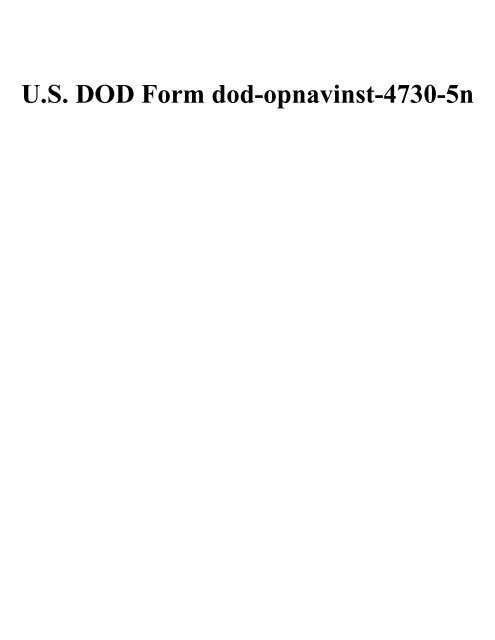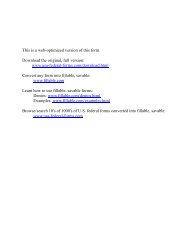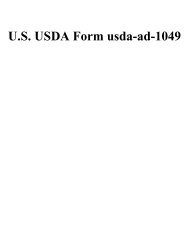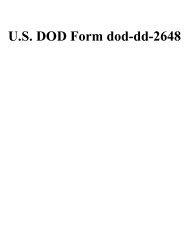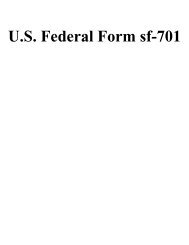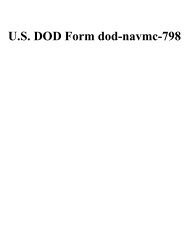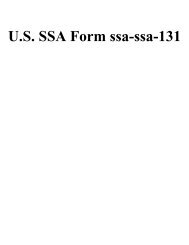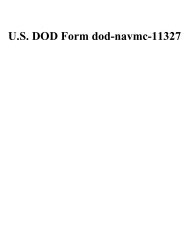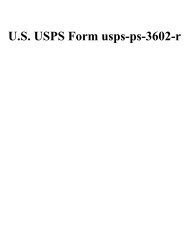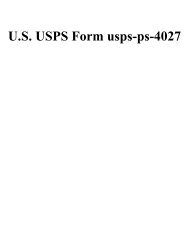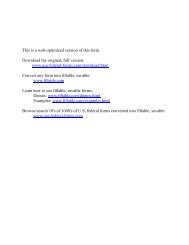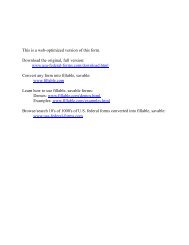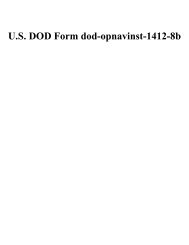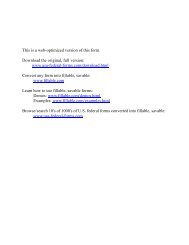(d) OPNAVINST 4730.7E
(d) OPNAVINST 4730.7E
(d) OPNAVINST 4730.7E
Create successful ePaper yourself
Turn your PDF publications into a flip-book with our unique Google optimized e-Paper software.
DEPARTMENT OF THE NAVY OFFICE OF THE CHIEF OF NAVAL OPERATIONS 2000 NAVY PENTAGON WASHINGTON, DC 20350-2000 <strong>OPNAVINST</strong> 4730.5NN09P31 Jan 03OPNAV INSTRUCTION 4730.5NFrom: Chief of Naval OperationsSubj: TRIALS AND MATERIAL INSPECTIONS (MI) OF SHIPS CONDUCTEDBY THE BOARD OF INSPECTION AND SURVEYRef: (a) U.S. Code, Title 10, § 7304(b) SECNAVINST 5040.3A Inspections Within DON(c) CNO WASHINGTON DC 252203Z SEP 98 (NAVOP 009/98) IDTCReductions(d) <strong>OPNAVINST</strong> <strong>4730.7E</strong> Material Inspections ofSubmarines by INSURV(e) <strong>OPNAVINST</strong> 4770.5F Instructions for InactiveShips and Craft(f) <strong>OPNAVINST</strong> 4700.8H US Naval Ships UndergoingConstruction or Conversion(g) <strong>OPNAVINST</strong> 4780.6D Policy for AdministeringService Craft and Boats (h) <strong>OPNAVINST</strong> 5430.48D OPNAV Organization(i) <strong>OPNAVINST</strong> 5090.1B Environmental and NaturalResources Program(j) <strong>OPNAVINST</strong> 5100.19D NAVOSH Program(k) INSURVINST 4730.1D Trials and Inspections ofShips1. Purpose. To set policy for Trials and Material Inspections(MI) of U.S. Naval vessels conducted by the Board of Inspectionand Survey (INSURV). These inspections provide assurance toSecretary of the Navy (SECNAV), Chief of Navy Operations (CNO),Fleets, System Commanders (SYSCOMs), Type Commanders (TYCOMs),and commanding officers that mechanisms to identify, document,and resolve material deficiencies are adequate; that thesesystems are being judiciously executed and are providing thecommensurate level of effectiveness, efficiency, and materialreadiness. This instruction has been substantially revised andshould be reviewed in its entirety.2. Cancellation. OPNAV Instructions 4730.5M.3. Background. Reference (a) prescribes that examinations ofnaval vessels be conducted by boards of naval officers in orderto make recommendations to the SECNAV as to which vessels, if
<strong>OPNAVINST</strong> 4730.5N31 Jan 03any, should be stricken from the U.S. Naval VesselRegistry. Per reference (b), these examinations shall provideassurance to SECNAV, CNO, and Fleets of an inspected unit’sfitness for service; identify material conditions that limitmission capability; and report to CNO, Fleets, and TYCOMsstatistical information regarding material deficiencies.Additionally, reference (b) establishes inspection policy whichpromotes ascertaining individual command’s self-assessmenteffectiveness. A skilled self-assessment capability promotesresponsibility and accountability within each command.Accordingly, each inspection report should be used to evaluatethe status of the command’s material readiness and its selfassessmenteffectiveness. As noted in reference (b), reports ofthe MI findings and recommendations will be provided to thecommanding officers and higher authority as appropriate in atimely, accurate, candid, and objective manner. Reference (c)and (d) provide guidelines for the periodicity of the MI.Reference (e) provides policy for material inspections of shipsand service craft scheduled for inactivation and disposal.Reference (f) provides policy for conducting trials andinspections associated with construction and conversion of U.S.naval ships. This instruction is augmented by reference (g)which provides policy and responsibilities for materialinspections of service craft.4. Responsibilities. SECNAV and CNO designate President, Boardof Inspection and Survey (PRESINSURV) as their agent to performthe following statutory, regulatory and contractualrequirements:a. Develop and establish CNO policy and procedures fortrials, material inspections, and surveys of ships and servicecraft consistent with law, regulations, and the terms ofcontracts (reference (h));b. Examine naval vessels periodically by a board of navalofficers to determine fitness for further service (reference(a));c. Conduct material inspections and surveys of ships andservice craft to determine the material readiness of thesevessels (reference (b));d. Provide independent verification of a newly constructedship’s readiness for acceptance/delivery; and to determine ifbuilder responsible equipment is operating satisfactorily duringthe guarantee period following acceptance (reference (f));2
<strong>OPNAVINST</strong> 4730.5N31 Jan 03e. Based on observations during INSURV assessments,provide timely, candid, and accurate findings to FleetCommanders, TYCOMs, SYSCOMs, and appropriate OPNAV officestogether with recommended actions where appropriate (references(b) and (h));f. Conduct environmental protection and naval OccupationalSafety and Health (NAVOSH) oversight inspection of naval shipsto include equipment, program compliance, and training. Acombined NAVOSH/EP assessment will be conducted duringinterdeployment training cycles (IDTCs), not to exceed 36 months(references (i) and (j));g. Compile statistical information and analyses onmaterial deficiencies, providing the CNO, FLEETs, Commander,Naval Sea Systems Command (NAVSEA, and other higher authoritiessuch information as they may require (reference (b));5. Trial and Inspection Precepts and Procedures. A materialinspection consists of a physical examination of the ship, itsspaces, and installed equipment. It includes witnessingdemonstrations of operating equipment and systems, and theexamination of appropriate records. The CNO will not issueprocedural directives (precepts) for the conduct of individualtrials and material inspections except where specialconsiderations are indicated. Procedures for conducting routinetrials and material inspections shall be specified by PRESINSURVand can be found in reference (k). Normally, trials andmaterial inspections will contain an underway period. However,if a ship is unable to achieve minimum criteria for safelyconducting underway operations within the designated inspectionperiod, the Board shall:a. Complete the examination to the best of its abilityinport;b. Identify those areas of the examination that were notcompleted and, as necessary, request that the cognizant TYCOMconduct those parts of the MI not completed and report resultsto PRESINSURV within 60 days of completion of the MI. INSURVwill provide assistance to TYCOM in completing this task ifrequested and if practicable;c. Designate the inspection as a “limited materialinspection (LMI)” (i.e. limited to an inport assessment);in order to consolidate inspections and avoid redundancy,deficiencies identified during other major ship3
<strong>OPNAVINST</strong> 4730.5N31 Jan 03inspections/assessments such as Combat Systems, Command,Control, Communication and Computer Readiness Assessment(C5RA)/Hull Mechanical Electrical Readiness Assessment (HMERA)shall be incorporated into the final INSURV inspection report ifthe assessment was conducted within 60 days of the scheduled MIor as negotiated between INSURV and the TYCOM. Althoughdeficiencies generated during the assessment will become part ofthe final INSURV report, these deficiencies will be annotated as“corrected” where applicable. TYCOM will document this linkedevent by message to INSURV, FTSC, and the affected unit fourmonths prior to the scheduled MI.6. Policy. Ship material inspection intervals and “overdue”determination will be based on the following:a. Active Ships(1) A ship's INSURV Material Inspection (MI) will bescheduled in accordance with current Commander Fleet ForcesCommand (CFFC) scheduling guidance. If a ship is not inspectedin accordance with CFFC scheduling guidelines it shall beconsidered overdue. The maximum interval between INSURVs isnoted in references (c) and (d) and shall not be exceededwithout a waiver granted by PRESINSURV. If the INSURVinspection due date occurs during Planned OperationalMaintenance (POM) or deployment, the INSURV inspection will bescheduled and conducted prior to POM and deployment. If aship's INSURV due date falls within a CNO-scheduled maintenanceavailability, the inspection date will be adjusted to occur atleast 4 months prior to the maintenance period start date.Optimum use of CFFC scheduling guidance should preclude overduesituations and waiver requests.(2) If an MI is scheduled following completion ofanother major pre-deployment assessment (e.g. C5RA, HM&ERA), theMI shall be separated from the end of the assessment by aminimum of 1 week.(3) Whenever practicable, inspections will be heldsufficiently in advance of a maintenance availability to permitincorporation of appropriate INSURV repair and alterationrecommendations in the authorized work package.b. Inactive Ships and Service Craft. Material inspectionsof inactive ships in Navy custody and ships or service craftscheduled for inactivation will be conducted in accordance withreference (e).4


